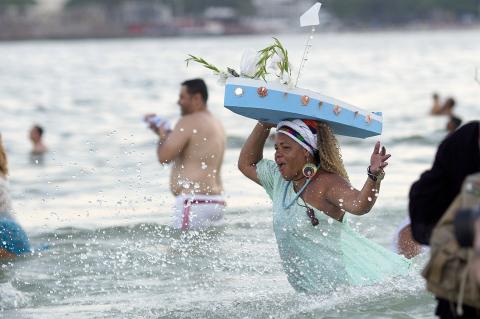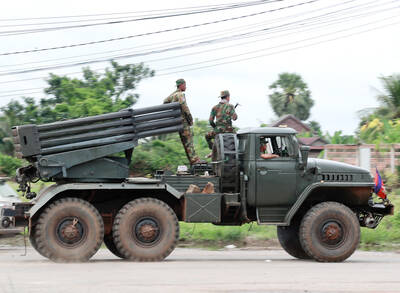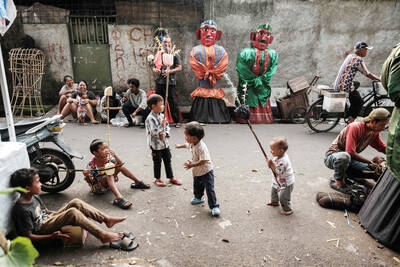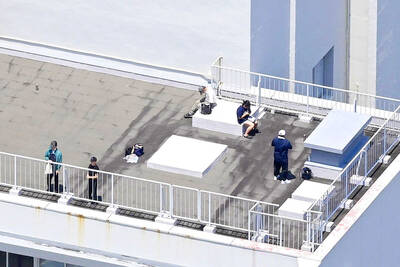Yellow underwear is flying off the shelves these days in the Chilean capital of Santiago, where tradition holds that it brings prosperity and love if you wear it on New Year’s Eve.
That is just one of many colorful New Year’s rituals in Latin America, where some spend the evening walking around with a suitcase, others put potatoes under the bed and still others throw buckets of water out the window.
“The yellow underwear is for love, luck, money and so that this year will go well for everyone,” said Gladys Leal, a saleswoman at a lingerie stand in Santiago’s Meiggs neighborhood.

Photo: AP
This time of year, she specializes in yellow undergarments in all shapes and sizes, for women and men alike.
However, there is a catch, said her colleague, Jesica Silva: “The underwear has to be given as a gift to bring luck.”
Yellow “represents the golden rays of abundance and prosperity,” she said.
Some even say the undies should be worn inside-out to guarantee a year full of passion.
“Beyond yellow lingerie, the tradition is more tied to the color itself,” said Chilean writer Hector Velis-Meza, author of a book called The Secret History of Christmas and New Year’s.
Yellow is seen in Latin America as a symbol of the sun, an eternal light, he said.
Chile is not the only country that adheres to the tradition.
It also exists in Mexico, Peru and Ecuador, with slight variations. Some say you should wear red undies for love, yellow for money.
In Uruguay, Argentina and Brazil, pink is the color of choice.
And in Venezuela, revelers are supposed to wear only new clothes — a tall order this year as the once-booming oil exporter struggles through an economic crisis.
For some, it is indispensable to welcome the New Year by eating lentils. For others, it is 12 grapes — one at each strike of the clock at midnight, a Spanish tradition.
In many countries, revelers ring in the new year by walking around the neighborhood with a suitcase, a ritual meant to guarantee a year of journeys.
In Uruguay, people often throw buckets of water out the window to wipe the slate clean for the new year. Some throw their old calendars, too.
In Brazil, many people dress in white and make offerings to Yemanja, the goddess of the sea.
Thousands of people swarm the beaches of Rio de Janeiro each year to launch makeshift boats with flowers and other gifts for Yemanja, seeking love, happiness or money.
Colombians put potatoes under their beds to bring good luck, while in Peru and Ecuador, revelers burn in effigy politicians and others they loved to hate in the outgoing year.
The custom has its roots in ancient indigenous practices in the Andes mountains.
However, for the most part, the region’s rituals have their origins in European traditions imported by Spanish and Portuguese conquistadores, Velis-Meza said.
That is the case for both the grapes and the lentils.
In Europe, the custom was to eat lentils, a hearty dish, in preparation for winter, he said.
In much of Latin America, though, New Year falls in the middle of summer.

POLITICAL PATRIARCHS: Recent clashes between Thailand and Cambodia are driven by an escalating feud between rival political families, analysts say The dispute over Thailand and Cambodia’s contested border, which dates back more than a century to disagreements over colonial-era maps, has broken into conflict before. However, the most recent clashes, which erupted on Thursday, have been fueled by another factor: a bitter feud between two powerful political patriarchs. Cambodian Senate President and former prime minister Hun Sen, 72, and former Thai prime minister Thaksin Shinawatra, 76, were once such close friends that they reportedly called one another brothers. Hun Sen has, over the years, supported Thaksin’s family during their long-running power struggle with Thailand’s military. Thaksin and his sister Yingluck stayed

In the sweltering streets of Jakarta, buskers carry towering, hollow puppets and pass around a bucket for donations. Now, they fear becoming outlaws. City authorities said they would crack down on use of the sacred ondel-ondel puppets, which can stand as tall as a truck, and they are drafting legislation to remove what they view as a street nuisance. Performances featuring the puppets — originally used by Jakarta’s Betawi people to ward off evil spirits — would be allowed only at set events. The ban could leave many ondel-ondel buskers in Jakarta jobless. “I am confused and anxious. I fear getting raided or even

Kemal Ozdemir looked up at the bare peaks of Mount Cilo in Turkey’s Kurdish majority southeast. “There were glaciers 10 years ago,” he recalled under a cloudless sky. A mountain guide for 15 years, Ozdemir then turned toward the torrent carrying dozens of blocks of ice below a slope covered with grass and rocks — a sign of glacier loss being exacerbated by global warming. “You can see that there are quite a few pieces of glacier in the water right now ... the reason why the waterfalls flow lushly actually shows us how fast the ice is melting,” he said.

Residents across Japan’s Pacific coast yesterday rushed to higher ground as tsunami warnings following a massive earthquake off Russia’s far east resurfaced painful memories and lessons from the devastating 2011 earthquake and nuclear disaster. Television banners flashed “TSUNAMI! EVACUATE!” and similar warnings as most broadcasters cut regular programming to issue warnings and evacuation orders, as tsunami waves approached Japan’s shores. “Do not be glued to the screen. Evacuate now,” a news presenter at public broadcaster NHK shouted. The warnings resurfaced memories of the March 11, 2011, earthquake, when more than 15,000 people died after a magnitude 9 tremor triggered a massive tsunami that